To age your homemade cheese naturally, you'll need a controlled environment like a basement or spare room with temperatures around 50°F (10-15°C) and humidity between 75-95%. Start by creating proper airflow using fans and monitor conditions with digital thermometers and hygrometers. Apply natural coatings like olive oil or wax, and use traditional techniques such as regular turning and brushing to develop ideal rinds. Keep your aging space clean and check daily for unwanted mold growth. Different cheese varieties require specific conditions, and mastering these fundamental techniques will reveal the rich flavors you're seeking.
Setting Up Your Aging Space

Setting up a dedicated cheese aging space starts with choosing the right location and environment. You'll need an area that maintains a consistent temperature of around 50 degrees Fahrenheit, which can be found in basements, garages, root cellars, or spare bedrooms during winter months.
If you don't have access to these spaces, you can convert an existing refrigerator or wine fridge into a cheese aging chamber. A temperature controller device can be added to ensure precise regulation of your aging environment.
To protect your cheese during the aging process, you'll need proper containment solutions. Use clean containers or aging boxes to shield your cheese from pests and contaminants.
If you're working with a natural environment like a cellar, it's vital to create a controlled space within it to maintain proper humidity and temperature levels.
For best results, incorporate devices that help manage environmental conditions. Install a hygrometer to monitor humidity levels, which should stay between 70% and 90%.
You can use misters, unheated propagators, or specialized equipment like the Cheese Grotto with clay bricks to maintain consistent humidity.
Don't forget to include fans or circulation systems to prevent the growth of unwanted bacteria and guarantee even temperature distribution throughout your aging space.
Essential Temperature Control Methods
You'll need to start by setting up a temperature-monitored aging space using digital thermometers and a temperature controller to maintain the ideal 50-59°F range for most cheeses.
Regular refrigerators run too cold and can dry out your aging cheese, making them unsuitable without proper modification.
Proper insulation of your cold room or aging space is essential, so consider using foam board insulation or converting a wine refrigerator that already has good insulation properties.
To prevent temperature fluctuations, you should seal any gaps in your aging space and position it away from heat sources or direct sunlight.
Monitored Aging Space Setup
Three essential components define a properly monitored cheese aging space: temperature control, humidity management, and air circulation. You'll need to set up your aging space with precision instruments to maintain these critical factors consistently.
For temperature control, install a reliable thermostat system that maintains 10-15°C (50-59°F) for most cheeses. You'll want to adjust these settings slightly for specific varieties – warmer for hard cheeses and cooler for blues. Mount a digital thermometer in an easily visible location and check it twice daily. Regular monitoring helps prevent harmful bacterial growth in the danger zone temperatures between 4°C and 60°C.
Your humidity management system should include both a hygrometer and a humidifier to maintain 80-95% relative humidity. Hard cheeses need less moisture (75-85%), while soft and blue varieties require higher levels (90-98%). Position your humidity equipment where it won't directly spray the cheese.
For proper air circulation, arrange wire racks with adequate spacing between cheese wheels. Don't overcrowd your aging space – each piece needs room for air to flow freely around it.
Install small fans if necessary, but avoid directing airflow straight onto the cheese. Remember to flip and rotate your cheeses regularly to guarantee even aging and prevent moisture buildup on any single surface.
Cold Room Insulation Techniques
Proper insulation serves as the foundation for maintaining precise temperatures in your cheese aging space.
You'll want to select insulation materials that not only provide excellent thermal resistance but also stand up to humidity. Foam insulation, available in both spray and board forms, offers one of your best options due to its versatility and effectiveness in maintaining consistent temperatures.
For ideal results, you'll need to layer your insulation strategy. Start with rigid foam insulation on your walls and ceiling, as it provides high R-values and long-lasting performance.
Consider adding reflective insulation as a secondary barrier, especially if your aging space receives direct sunlight or sits against an exterior wall. In areas where moisture is a particular concern, cellular glass insulation proves invaluable due to its water-resistant properties.
Don't overlook the importance of sealing gaps and joints between insulation panels. You can use spray foam to fill these spaces, ensuring there aren't any thermal bridges that could compromise your temperature control.
If you're working with an existing room, fiberglass insulation can work effectively when properly installed between wall studs and protected with a vapor barrier.
Managing Humidity Levels
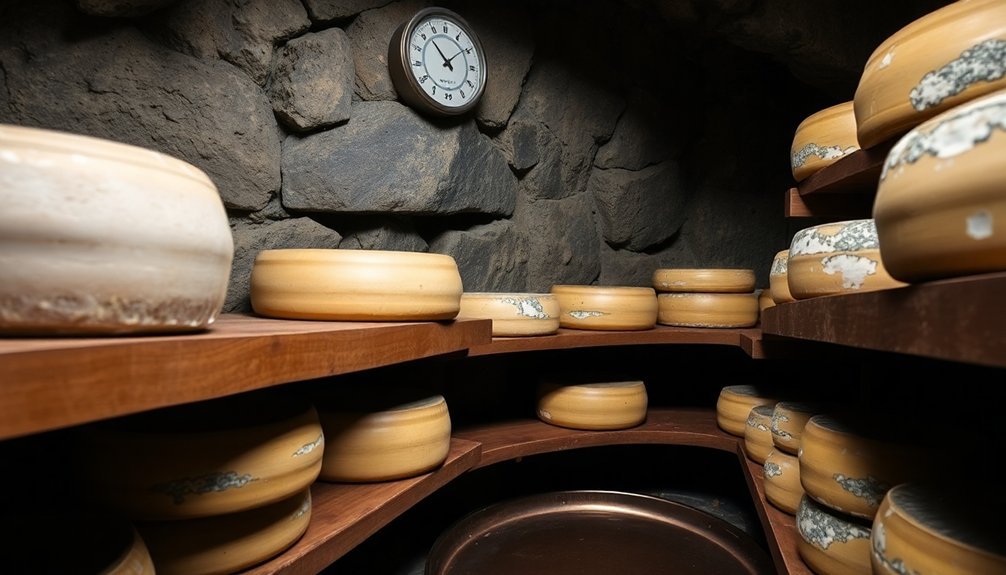
You'll want to monitor your aging space's humidity levels daily using a reliable hygrometer to maintain ideal conditions for your cheese.
Check for any signs of excess surface moisture, which can lead to unwanted mold growth and spoilage.
If you notice water droplets forming on your cheese's surface, improve air circulation with a small fan and adjust your humidity control methods using water trays or humidistats.
Measuring Daily Moisture Levels
Maintaining precise humidity levels stands as a cornerstone of successful cheese aging, requiring daily monitoring and adjustments to achieve ideal results. To measure moisture effectively, you'll need a reliable hygrometer – either analog or digital – properly calibrated and positioned in your aging space.
Different cheese varieties demand specific humidity ranges. You'll want to maintain 90-95% relative humidity for soft and fresh cheeses, while semi-soft varieties thrive at 85-90%. Hard cheeses require 80-85%, and very hard cheeses need 75-80%. If you're using cold storage, aim for 60-65% relative humidity.
Monitor your hygrometer daily and adjust conditions as needed using various methods. You can increase humidity by adding water trays, using damp cloths, or employing a humidifier. For precise control, consider installing a humidistat.
Don't forget to maintain proper air circulation around your cheese using cheese mats or wood boards to prevent unwanted condensation. Regular cleaning of your humidification system helps prevent contamination, while consistent temperature control supports stable humidity levels.
Remember that colder air holds less moisture, so you'll need to factor this into your measurements and adjustments.
Preventing Excess Surface Dampness
While achieving ideal humidity levels is essential for cheese aging, preventing excess surface dampness requires a balanced approach using multiple control methods.
You'll need to combine proper equipment with natural solutions to maintain the perfect environment for your aging cheese.
Start by installing a humidifier with a reliable controller that's appropriate for your aging space size. Position the sensor at cheese level and calibrate it regularly to guarantee accurate readings.
For natural humidity control, you can use water or salt solutions, but remember to change them daily to prevent contamination.
Here's what you'll need for effective moisture management:
- A small fan to maintain consistent air circulation and prevent moisture from settling on cheese surfaces
- Aging mats made from bamboo or food-grade plastic to promote even moisture distribution
- Clean, damp cloths or paper towels to create localized humidity zones
- Proper ventilation methods, including brief door openings when needed
Don't forget to turn your cheese regularly and wipe away any excess moisture that develops on the surface.
For smaller batches, create controlled microenvironments using plastic containers with dampened paper towels, but always sanitize your equipment between uses to prevent unwanted mold growth.
Natural Rind Development
To develop a natural rind successfully, cheese wheels must be aged in carefully controlled environments with precise humidity levels between 90-98% and temperatures ranging from 10-15°C.
You'll need to start by applying either a brine solution or dry salt rub to your fresh wheels of pressed curds, which helps initiate the rind formation process.
As your cheese ages, you'll notice microbial cultures beginning to work on the surface, breaking down proteins and fats while contributing to flavor development.
You'll need to brush the rind regularly to control mold growth and prevent overdevelopment. Apply food-grade oil to protect against cheese mites and unwanted flora when necessary.
Monitor your aging cheese wheels frequently for signs of excessive mold growth or mite activity.
You'll see the rind gradually develop earthy, musty flavors as beneficial bacteria and molds establish themselves. The enzymatic activities occurring on the surface will release volatile compounds, creating complex flavor profiles and affecting the cheese's texture.
If you're using a cheese cave or aging space, keep the shelves clean and maintain consistent environmental conditions to guarantee proper rind development throughout the aging process.
Traditional Turning Techniques
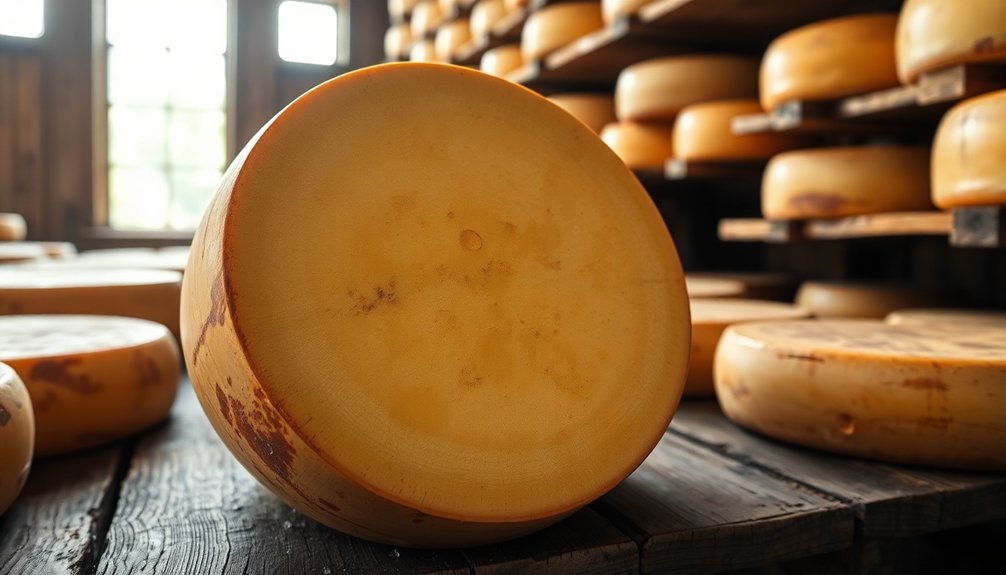
Regular turning stands as one of the most critical steps in traditional cheese aging. When you're aging cheese, you'll need to turn it consistently to guarantee even distribution of moisture and fat throughout the wheel. This process prevents dry spots and helps develop a uniform texture and flavor profile in your cheese.
You'll typically want to perform your turns on a weekly basis, though specific cheese varieties may require different schedules. The basic process involves removing the cheese from its mold, gently lifting off the cloth, flipping the wheel, and replacing it in the lined mold. For best results, you'll need to monitor your cheese's condition and adjust the turning frequency accordingly.
Here's what you'll need to maintain proper turning practices:
- A stable environment with controlled temperature and humidity
- Clean wooden shelves or aging boards
- Fresh cheese cloth for each turn
- Sanitized hands or gloves for handling
Whether you're using a natural cave, cellar, or modified refrigerator as your aging space, consistent turning helps maintain the perfect conditions for your cheese's development. The key is to remain gentle with initial turns when the curds are still delicate.
Mold Prevention and Management
Protecting your aging cheese starts with spotting early warning signs of unwanted mold, including discolored spots, fuzzy patches, or unusual odors.
You'll need to act quickly when you notice these signs, as mold can spread rapidly through your cheese if left unchecked.
For hard cheeses, you can safely remove small amounts of mold by cutting at least one inch around and below the affected area, but soft cheeses should be discarded entirely if any mold appears.
Early Signs of Mold
A cheesemaker's success in aging depends heavily on recognizing the earliest signs of mold development. While some molds are beneficial, like the white *Penicillium candidum* in bloomy rind cheeses or blue-green *Penicillium roqueforti* in blue cheeses, you'll need to watch carefully for unwanted varieties that can spoil your cheese.
You should regularly inspect your aging cheese for these early warning signs:
- Any pink, red, orange, or black spots, which indicate harmful mold growth that requires immediate removal of the affected cheese
- Unexpected blue or green patches on cheeses that aren't meant to be blue-veined
- Unusual moisture or dampness on the cheese surface, which can lead to rapid mold development
- Off-putting odors that don't match the expected aroma of your cheese variety
If you spot these signs, don't take chances – especially with black mold, which is typically toxic.
You'll want to maintain proper humidity levels and temperature control in your aging space while guaranteeing adequate ventilation.
Remember to seal your cheese properly using vacuum sealers or cheese paper wrapped in foil, and store it in the refrigerator immediately after handling.
Regular monitoring and quick response to early signs will help guarantee your cheese ages safely and naturally.
Safe Removal Techniques
Once you've identified unwanted mold on your cheese, knowing how to remove it safely can mean the difference between saving and wasting your product.
For hard and semi-hard cheeses like cheddar or Gouda, you'll need to cut at least a quarter-inch around and below the moldy area using a clean, sharp knife. Don't let your knife touch the mold before cutting into clean cheese sections to prevent cross-contamination.
You can also try the vinegar treatment method by wiping moldy spots with a white vinegar-soaked cloth. After treatment, let your cheese air dry briefly before rewrapping.
For ongoing protection, wrap the cheese in a vinegar-dampened paper towel and store it in an airtight container.
When handling cheese, always use food-grade plastic gloves or a piece of plastic wrap as a barrier to minimize bacterial transfer.
After removing mold, wrap your cheese tightly in plastic wrap or cheese paper, then add an aluminum foil layer for extra protection.
Remember to discard soft cheeses like cream cheese or Brie if you find any mold, as these varieties can't be safely salvaged.
Environmental Factors for Success
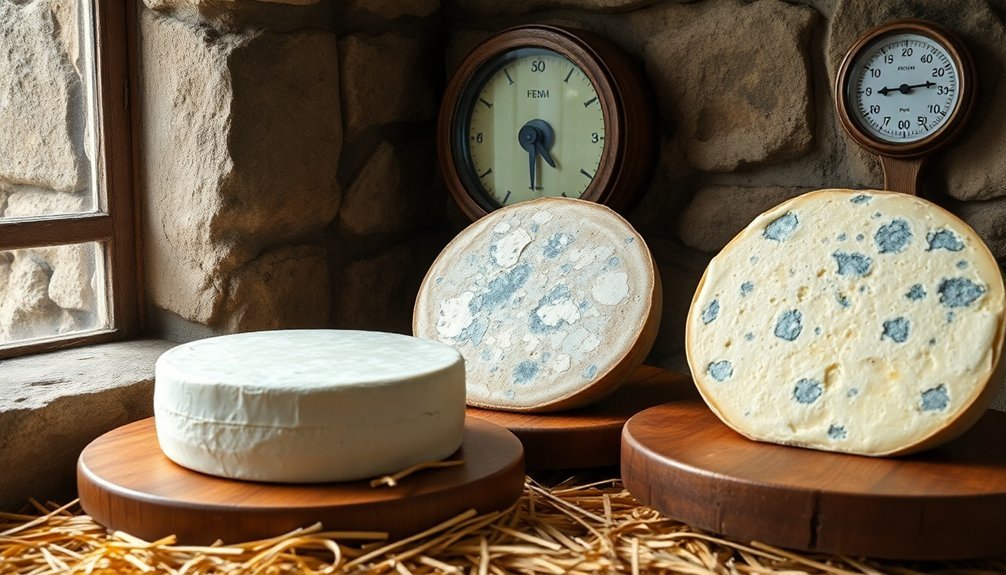
Successful cheese aging depends on carefully controlling four key environmental factors: temperature, humidity, air circulation, and microbial conditions. Most cheeses thrive in cool environments between 10-15°C (50-59°F), though specific varieties like Cheddar need cooler temperatures of 4-8°C (39-46°F).
You'll need to maintain relative humidity between 65-95%, depending on your cheese type. For ideal aging results, you should focus on these essential environmental aspects:
- Keep temperatures steady using a reliable thermometer, adjusting for hard cheeses (40-55°F) and soft cheeses (55-60°F).
- Maintain proper humidity by using wet towels, water-filled sponges, or salt bowls, aiming for 80-95% for most varieties.
- Guarantee gentle, consistent airflow to prevent excessive drying while allowing proper gas exchange.
- Create clean, seamless aging spaces to control desired microflora development.
Proper air circulation is vital but shouldn't be excessive, as high airflow can dry out your cheese or disrupt rind formation.
If you're aging multiple cheeses, they'll contribute to the overall humidity, potentially reducing the need for additional moisture sources. Monitor your aging space's dew point to better understand the surrounding water activity.
Creating Perfect Aging Conditions
Creating perfect aging conditions requires an all-encompassing approach to temperature, humidity, and air circulation management.
You'll need to maintain temperatures between 7° and 14° Celsius, though specific cheeses may require different ranges. Since your home fridge won't provide ideal conditions, consider using a wine fridge or a converted refrigerator with a temperature regulator.
For ideal aging, you'll want to keep humidity levels between 75% and 95%, adjusting based on your cheese type.
Use a hygrometer thermometer to monitor these levels accurately. If conditions become too dry, place a wet paper towel or shallow pan of water in your aging space to increase moisture.
Don't overlook proper air circulation, as it's essential for preventing unwanted molds and ensuring even aging.
You'll need to monitor your cheese regularly for signs of improper ventilation, such as Slip Skin. Make sure to turn, flip, and pat your cheese as needed, keeping detailed records of the process.
When maintaining your aging environment, always use sterile water and materials to prevent contamination.
You may need to adjust conditions seasonally, so stay vigilant with your monitoring routine.
Natural Coating Materials
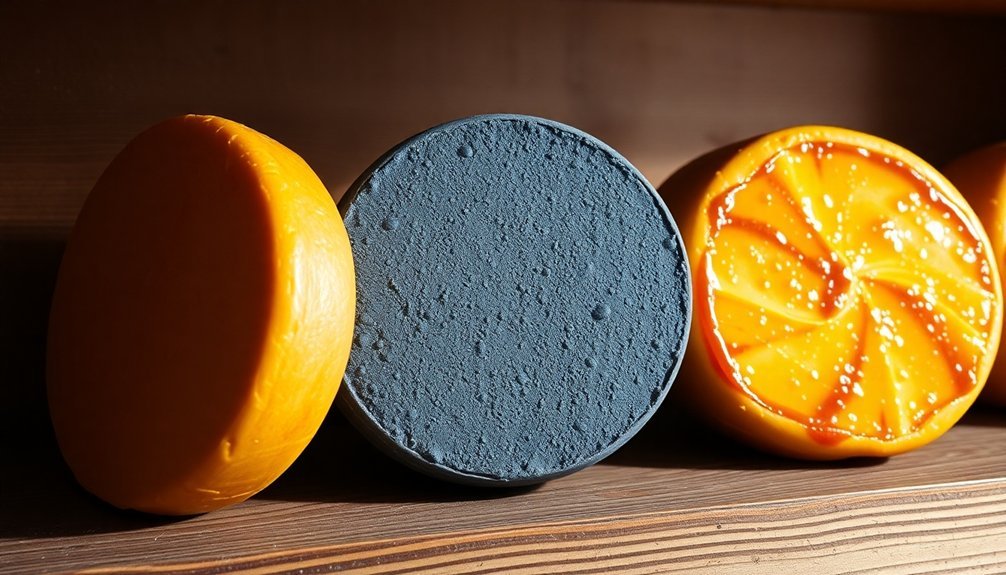
A cheese's longevity depends heavily on its protective coating during the aging process. You'll find several natural options to protect your aging cheese, each with unique benefits for different cheese styles and aging goals.
Wax coating offers excellent protection when applied in three layers at 200°F. It's particularly effective at preventing moisture loss and unwanted mold growth. If you're not comfortable with cheese wax, you can opt for paracoat as a simpler alternative.
For those seeking a more traditional approach, olive oil coating provides a natural way to maintain moisture while developing rinds. You can later combine this method with vacuum sealing for extended aging periods.
Natural rind development, while requiring more attention through daily brining and flipping, allows your cheese to form its own protective barrier.
- Bandage wrapping with cheesecloth protects against surface aging
- Natural rinds need proper ventilation and regular inspection
- Wax coating requires multiple layers for effective coverage
- Olive oil can be used alone or with vacuum sealing
When selecting your coating method, consider your cheese type, aging duration, and available equipment. Each technique requires specific maintenance routines to guarantee successful aging.
Tracking Your Aging Process
Proper tracking serves as the backbone of successful cheese aging. You'll need to maintain detailed records of your aging process to consistently produce high-quality cheese and replicate your successes. Using an Affinage Record form, document essential factors like temperature, humidity, and air circulation throughout the aging period.
Start by recording the initial cheese-making process, then consistently track your aging environment's conditions. You'll want to note any changes or interventions you make, such as flipping the cheese or adjusting humidity levels.
Keep your tracking tools, including temperature and humidity control devices, readily available for regular monitoring. Your records should include specific observations about the cheese's development, including texture changes, rind formation, and any unusual characteristics.
By maintaining detailed aging journals, you'll quickly identify patterns and potential issues before they become problems. When you experiment with different aging times or conditions, these records become invaluable in determining what works best for each cheese variety.
Remember to utilize online resources and cheese-making guides to compare your results with established standards and continuously improve your aging techniques.
Signs of Proper Aging
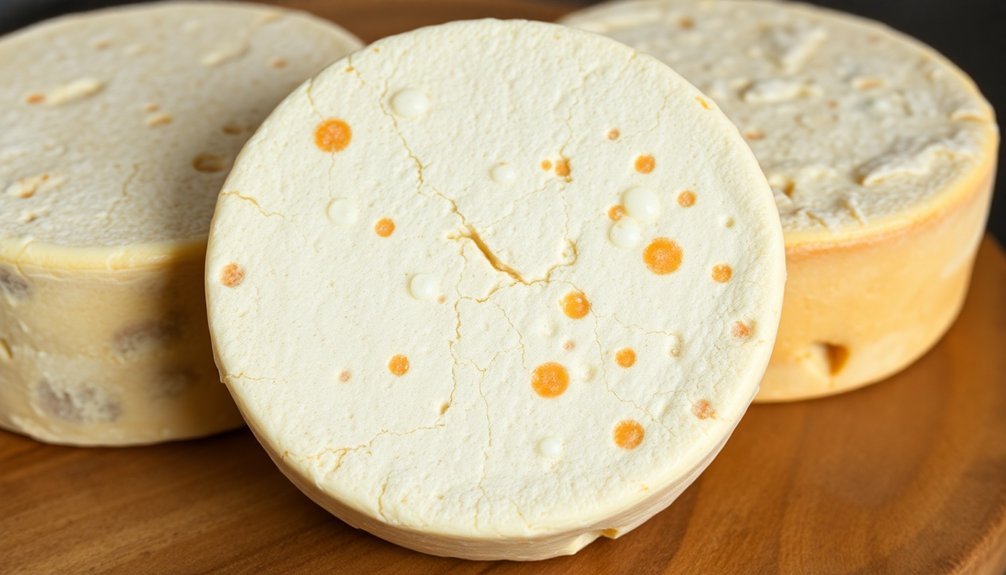
Successfully aged cheese reveals distinct visual and tactile indicators that confirm proper maturation. You'll notice your cheese developing specific characteristics based on its type and the microbial activity occurring during the aging process.
- Your cheese's surface should show appropriate microbial growth – white and fuzzy for Camembert-style, blue-green veining for blue cheese, or orange-reddish hues for washed-rind varieties.
- The texture should become progressively firmer for hard cheeses or develop the desired level of softening for soft-ripened types, indicating proper proteolysis.
- The aroma should intensify and become more complex over time, with no off-putting smells that might indicate spoilage.
- The rind should form evenly without cracking or excessive drying, suggesting proper humidity control.
You'll know your cheese is aging correctly when you observe consistent temperature readings between 40-60°F, depending on the cheese type.
The surface shouldn't appear overly dry or wet, and any mold growth should match the expected patterns for your specific variety.
The cheese's body should transform gradually, becoming either firmer or creamier based on the style you're aging.
Frequently Asked Questions
Can I Age Different Types of Cheese Together in the Same Space?
You can age different cheeses together, but you'll need to separate soft-ripened from hard cheeses, and keep strong-smelling varieties away from mild ones. Maintain proper temperature and humidity for each type.
How Do I Know When My Cheese Has Aged Too Long?
You'll know your cheese has aged too long if you notice sour or ammonia smells, unusual textures, visible mold (except on blue cheese), or significant taste changes. Watch for sliminess in soft cheeses and brittleness in hard ones.
What Causes Cheese to Develop Cracks During the Aging Process?
Your cheese can develop cracks due to low humidity, improper cooling before pressing, acidic brine, or uneven cheesecloth placement. You'll want to maintain 65-75% humidity and guarantee proper temperature control during aging.
Should I Remove the Existing Rind Before Waxing My Aged Cheese?
No, you shouldn't remove the existing rind before waxing. It's a crucial protective barrier that's part of your cheese's natural aging process. Keep the rind intact and just clean it thoroughly before applying wax.
Why Does Some Aged Cheese Develop Crystals Throughout the Aging Process?
You'll notice crystals forming in aged cheese when proteins and fats break down over time. These crunchy bits, mainly calcium lactate and tyrosine crystals, develop as bacteria work and proteins separate during aging.
In Summary
You'll find that aging cheese naturally at home requires patience, attention to detail, and careful monitoring of your environment. When you've mastered temperature control, humidity management, and proper turning techniques, you're well on your way to creating artisanal cheeses. Keep detailed records of your aging process, trust your senses, and don't be afraid to experiment. With practice, you'll develop the skills to produce perfectly aged cheeses.

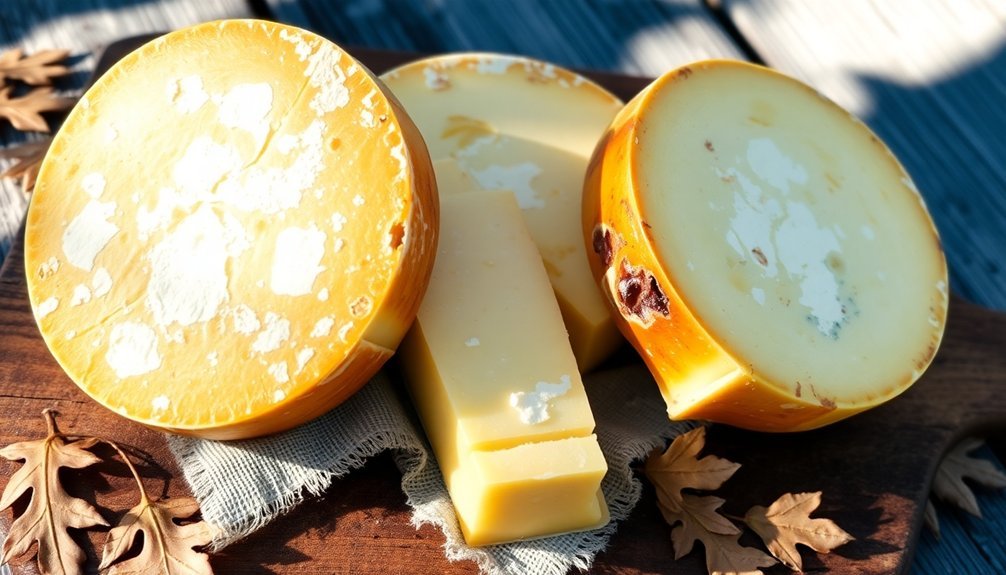

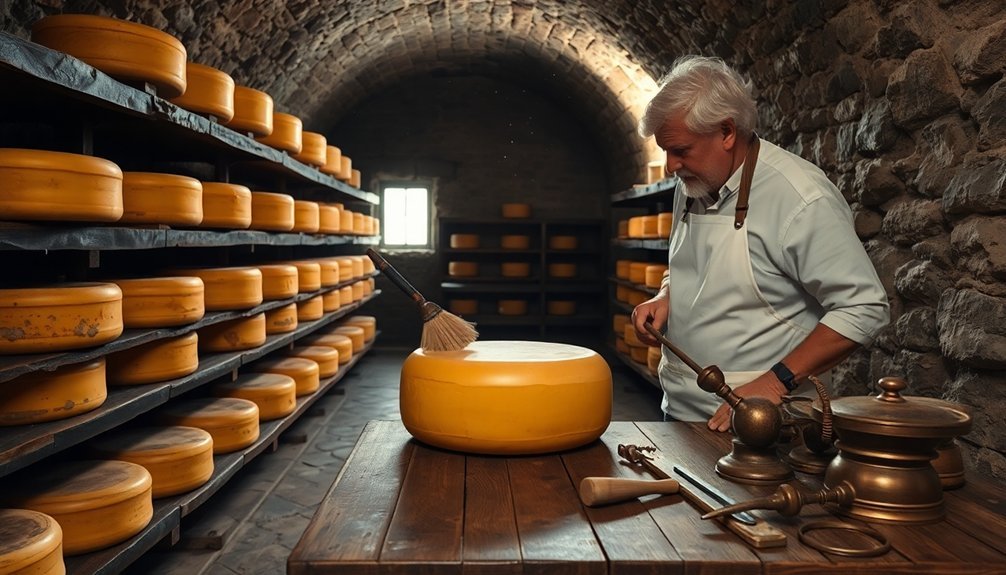
Leave a Reply